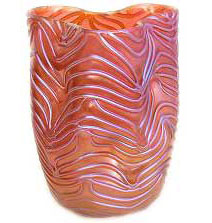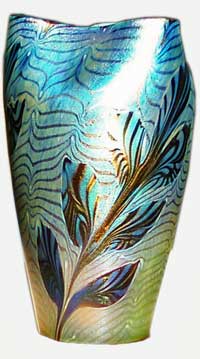Art Glass

U.S. Studio Art Glass, Before and After Chihuly
By Maribeth Keane and Brad Quinn — In 2010, we spoke with Seattle-based artist Benjamin Moore (1952-2021) about the origins of the American Studio Art Glass Movement and how it benefited from the combination of traditional European techniques and an American attitude of collaboration and experimentation. : Marvin Lipofsky introduced me to glass while I was getting a bachelor’s degree in ceramics at the California College of Arts in Oakland, California. One day I saw a poster there for the Pilchuck Glass School,...

Candlesticks from Sandwich and Points West
By Thomas H. Ormsbee — The dolphin candlestick and its various half brothers, the fluted column, the loop-and-petal and the baluster, have been popular with collectors for many years. They have been sought in all variations of form and color and one would expect a well-annotated family history had long since been compiled. On the contrary, in the literature of American glass one finds only occasional and brief references to these distinctive and decorative candlesticks. That they were first produced at...

Colorful American Blown Glass in the Victorian Manner
By Charles Woolsey Lyon — American glass of the last quarter of the 19th Century means to many nothing but pattern glass. Yet during this same period tremendous advances in the art of blown glass were made by four or five men of genius working in the few factories where appreciation of the glassblower's skill and creative ability still continued, and where it was realized that there was still an excellent market in America for delicately blown and colorful glass. Naturally, it was Victorian in design and spirit, but...

Modern Glass Blowing Still Adheres to Ancient Traditions
By American Collector Staff — Although the gaffer and his servitor seen in these pictures wear the clothes of today, they are actually following the same steps and using the same tools that glass blowers have used for centuries. These pictures, taken at the Steuben works of the Corning Glass Company, show the successive steps in making a piece of fine hand-blown glass. The tools, blow pipe, pontil rod, bench, tongs and wooden paddles are practically the same as those used in making the rarest off-hand specimens of...

Loetz Glass Collector Eddy Scheepers on the Pride of Bohemia
By Maribeth Keane — Loetz was a Bohemian company. It was a factory; and the region’s biggest and best glass manufacturer. There were other contemporaries like Kralik, Rindskopf, and Pallme-Konig that produced glass in the same style, made almost in the same way, but not always with the same quality. The glass is covered with vapors of metals, like silver, for instance. Most Loetz glass was not free-blown like most people think; ninety-five percent was blown in molds. Some people think some of the glasses...

Getting Lost in Strathearn Art Glass Paperweights
By Maribeth Keane — In 1998, while going through my parents' estate, my wife and I found some glassware made by Anchor Hocking between the 1940s and the 1960s as promotional items for laundry detergent and gas stations. My parents had recently been killed in an automobile accident, and my wife said, “Hey, it’d be a good idea to try to put this set together in memory of your mother,” so we started visiting antique shops to see if we could find more. We gradually put a set together and found others in different...

Reyne Haines Spills on Tiffany, Chihuly, and Loetz
By Dave Margulius — I started becoming interested in art glass when I moved from Texas to New York, and wanted to decorate my apartment with New York-type things, things I had never seen in Houston. I grew up in Texas, which is a relatively new state. While there’s a lot of money in Texas, we didn’t have a Tiffany’s, we didn’t have a Marshall Field’s, or companies that sold Baccarat or Lalique or Tiffany or Steuben or any of the bigger makers. Nobody in my family really collected anything, and I wouldn’t say...